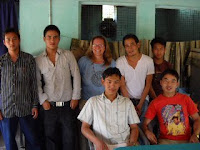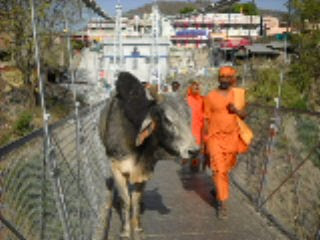Two months in Rishikesh, and it was over in the blink of an eye. Each day was perfect and very much like the one before. Here is how my typical day begins:
No alarm clock is needed, because the sounds of India begin early. My hotel is located next to a school/orphanage, and the talking, yelling, laughing of children begins as soon as they awake, which is usually by 7:00am. As does the never-before-heard sound of a man...coughing? Vomiting? Hacking up phlegm? No, just a curious combination of all three.
The bathroom is equipped with a showerhead, but the bucket bath provides more water pressure. Once I am as clean as India water allows, and my laundry is washed and hanging on the line, I am out into the high winds that sail through this part of the Ganga river valley.
My first destination is Cafe Coffee Day for the most perfect Cafe Americano, which is known here as "Black Coffee." Enroute I pass under the construction zone that rains dirt and debris down on my head. Then the smell alerts me to the pissing wall, where all the men in the area pee. "All the men" includes the uniformed Royal Air Force guys, the local police, and every other male who works and lives in the vicinity. The six-foot high brick wall is stained from their efforts, and the dirt beneath it is always wet.

The Laksman Jhula bridge provides the link between two busy parts of the town, and is designed for foot traffic only. Here mopeds, motorbikes, and motor cycles pass for pedestrians, and the bridge is a crazy thoroughfare of swaying Indians, honking two-wheelers, and westerners intent on bypassing the meandering crowd. The Indians - no offense intended - are not good walkers. They stop, gape, take photos, weave, and huddle in groups, and the old aunties wobble from side to side as they walk barefoot with their families. An Indian is never alone, always accompanied, and frequently a part of an extended family group. This is maddening to the independent westerner, whose only goal is to
cross the damn bridge.

I cross the bridge twice a day, once in each direction, and I am quite efficient at it. But for many of these people, this is their first time, and to be fair, the view is splendid. I am here during the Kumbh Mela pilgrimage, taking place in Haridwar, an hour away. The temple town of Rishikesh is an important stop for the pilgrims. It's on the holy Ganga river and is loaded with Hindu temples. I don't know for sure, but I believe that many of the pilgrims visiting Rishikesh have never been here before, and many have never left their villages before making this pilgrimage. Imagine the wonder and excitement! Everything new and different and foreign. So much stimulus!

Once over the bridge, I pass the Shiva statue, the CD vendors with their dueling displays of Bollywood music; the boys selling bindis (the things women stick on their foreheads), postcards, and tourist maps of India; the shawl shops; and the jeep taxis with their horns blaring. This is the busiest part of Laksman Jhula. It's madness, most of the time, and I love it. It's so intimate, and so familiar, and so
India. And at this point, I know that my coffee shop is only a minute away.

When I walk in the door of Cafe Coffee Day, the boys greet me with a smile and, "black coffee, madam?" I never drank coffee before walking the Camino in Spain in 2007. I don't drink it for the caffeine but rather for the taste. And this 'black coffee' is perfectly strong and delicious, and once I get it doctored, it tastes like the hot/liquid version my favorite coffee ice cream. Coffee Day has A/C, the two local newspapers, and comfortable chairs. Their tagline is "A lot can happen over coffee."

I have met several of my closest Rishikesh friends here, and have learned a lot about India from the papers (for example, 14 people die each hour in traffic incidences in this country; curiously, the same number of people commit suicide each hour; these statistics were reported in the paper on the same day, different pages).
And so my day begins...


































































